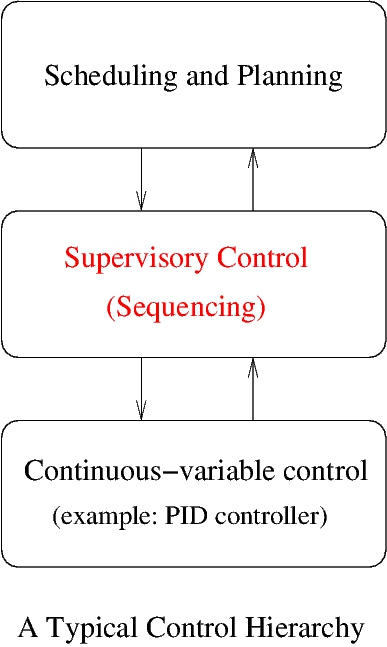|
 Research
Interests Research
Interests
My research group's activities lie in the area of Systems and
Control. We study:
Supervisory control
Fault diagnosis
Modeling and analysis of biological systems.

The main tools of our analysis (and the link among the
above three topics) are
Discrete-Event models.
Examples of Discrete-Event Systems (DES) are finite-state automata
and Petri nets. DES models are used in the study of a wide range of problems
in aerospace, process control, software
engineering, automated manufacturing and
biological systems. Compared with continuous-variable models (such as
differential equations), DES models are coarser and provide less detail.
Therefore, they are typically used where studying systems at higher levels
of abstraction is desired. The use of finite-state machines in the design
of logic circuits is one example. Another example can be found in
Control Hierarchies.
Control systems usually have a hierarchical organization. A typical
control hierarchy has three levels. The lowest level involves
continuous-variable feedback loops (e.g, PID control loops).
The next level up deals with sequencing and supervisory control
(e.g., plant start-up and shutdown sequences, enablement/disablement
of control loops). DES models are suitable tools for the analysis and
design of these command sequences. At the highest level of the
hierarchy, controllers are concerned with longer-term planning and
production scheduling tasks.
Our research primarily focuses on the following topics.
Supervisory control: We develop methods for
designing
supervisory control systems that are robust
with respect to plant model uncertainties or changes.
Plant model changes can be, for instance, the result of
a component failure. In such cases, the controller is expected
to be able to meet the design specifications of both
normal and faulty modes of operation of the plant. Therefore robustness
plays an important role in developing fault recovery
procedures.
Fault diagnosis:A significant portion of "control"
code in real-world systems (up to 80% in some cases) is dedicated to
test and diagnosis. DES models are suitable for designing monitoring
systems that diagnose drastic failures such as "valve stuck-closed"
or "sensor short-circuited". The resulting diagnosis systems, in
combination with fault recovery procedures, could serve:
(1) to enhance the level of autonomy of unmanned systems, and
(2) to assist human operators (in manned systems) with handling
failures.
Modeling biological systems: Over the
past decade or so, obtaining experimental data for biological
systems has become to some extent easier and less expensive. Many
methods of
analysis in engineeering and computer science are applied (or adapted
for application) to these data to better understand the
underlying biological
phenomena. Biological systems, similar to many control systems,
have a hierarchical organization. Various types of models, such as
differential equations and DES models, are used to study these
hierarchies.
We develop algorithms for analysis, assessment and comparison of
various models of the protein interactions and methobolic pathways in
cells.
Software tools: We have developed
Discrete Event Control Kit (DECK),
a toolbox (set of M-file functions) written in the programming language
of
MATLAB for the analysis and design of supervisory
control systems based on discrete-event models. DECK has been developed
in the familiar environment of MATLAB as an educational tool, and
provides a convenient setup for implementing new algorithms to assist
in research.
Last updated October 28, 2024.
|




 Research
Interests
Research
Interests